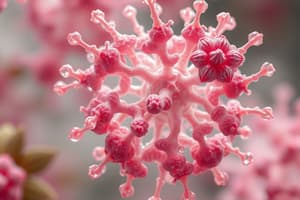Podcast
Questions and Answers
What is the characteristic of lipids in terms of solubility?
What is the characteristic of lipids in terms of solubility?
- Insoluble in all solvents
- Soluble in polar solvents
- Soluble in both polar and nonpolar solvents
- Soluble in nonpolar solvents (correct)
What is the energy value of 1 gram of fat?
What is the energy value of 1 gram of fat?
- 12 calories
- 4 calories
- 9 calories (correct)
- 7 calories
What is the function of phospholipids in the inner mitochondrial membrane?
What is the function of phospholipids in the inner mitochondrial membrane?
- Electron transport chain (correct)
- Cell membrane structure
- Cell signaling
- Protein synthesis
What type of fatty acids contain double bonds?
What type of fatty acids contain double bonds?
What is the typical range of carbon atoms in fatty acids?
What is the typical range of carbon atoms in fatty acids?
What is the characteristic of the hydrocarbon tail of fatty acids?
What is the characteristic of the hydrocarbon tail of fatty acids?
What is the derivative of cholesterol?
What is the derivative of cholesterol?
What is the function of lipids in regulating membrane permeability?
What is the function of lipids in regulating membrane permeability?
What is linolenic acid?
What is linolenic acid?
What is the effect of double bonds on the melting points of fatty acids?
What is the effect of double bonds on the melting points of fatty acids?
What are essential fatty acids?
What are essential fatty acids?
What is the shorthand representation of oleic acid?
What is the shorthand representation of oleic acid?
What is the symbol used to indicate the site of unsaturation in a fatty acid?
What is the symbol used to indicate the site of unsaturation in a fatty acid?
What is the meaning of the number in a shorthand representation of a fatty acid?
What is the meaning of the number in a shorthand representation of a fatty acid?
What is arachidonic acid?
What is arachidonic acid?
What is palmitoleic acid?
What is palmitoleic acid?
Flashcards are hidden until you start studying
Study Notes
Introduction to Lipids
- Lipids are hydrophobic, nonpolar molecules that are soluble in nonpolar solvents and insoluble in polar solvents, such as water.
- Major types of lipids include fatty acids, triglycerides, steroids, and eicosanoids.
Functions of Lipids
- Lipids are a source of high energy value, with 1 gram of fat providing 9 calories.
- They are constituents of membrane structure and regulate membrane permeability.
- Lipids serve as a source of fat-soluble vitamins (A, D, K, and E).
- They are important as cellular metabolic regulators (steroid hormones and prostaglandins).
- Phospholipids participate in the electron transport chain as components of the inner mitochondrial membrane.
Fatty Acids
- Fatty acids contain a carboxylic acid group, which makes them polar, but they also have a long hydrocarbon tail that makes them nonpolar overall.
- Fatty acids typically contain between 12 and 20 carbons, usually an even number.
- Saturated fatty acids have no carbon-carbon double bonds, while unsaturated fatty acids have double bonds and polyunsaturated fatty acids (PUFAs) have multiple sites of unsaturation.
- Melting points for saturated fatty acids increase with the number of carbons.
- Unsaturated fatty acids can be monounsaturated or polyunsaturated, and have lower melting points than saturated fatty acids.
- The double bonds in fatty acids are usually cis, which lowers the melting points.
Essential Fatty Acids
- Essential fatty acids (EFAs) cannot be synthesized by the body and must be supplied in the diet.
- EFAs are unsaturated fatty acids, including linoleic acid (18:2;9,12), linolenic acid (18:3;9,12,15), and arachidonic acid (20:4;5,8,11,14).
Shorthand Representation of Fatty Acids
- The general rule for shorthand representation of fatty acids is to write the total number of carbon atoms, followed by the number of double bonds, and finally the position of double bonds, starting from the carboxyl end.
- Examples include palmitic acid (16:0), oleic acid (18:1;9), and arachidonic acid (20:4;5,8,11,14).
Delta System
- The site of unsaturation in a fatty acid is indicated by the symbol Δ and the number of the first carbon of the double bond relative to the carboxylic acid group (–COOH).
- The delta system is used to designate the position of double bonds, with carbon 1 being the carboxylic acid group.
Studying That Suits You
Use AI to generate personalized quizzes and flashcards to suit your learning preferences.




